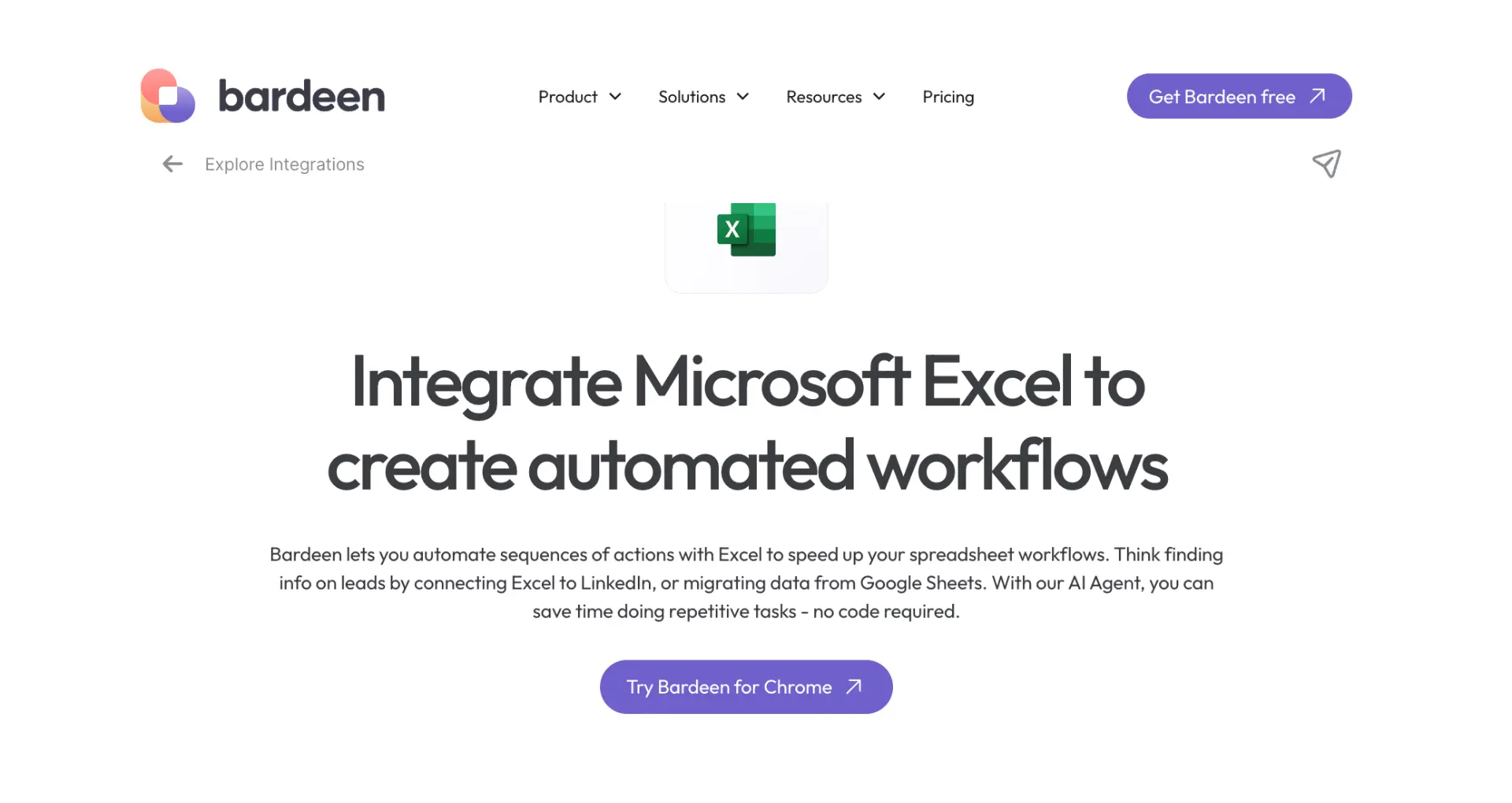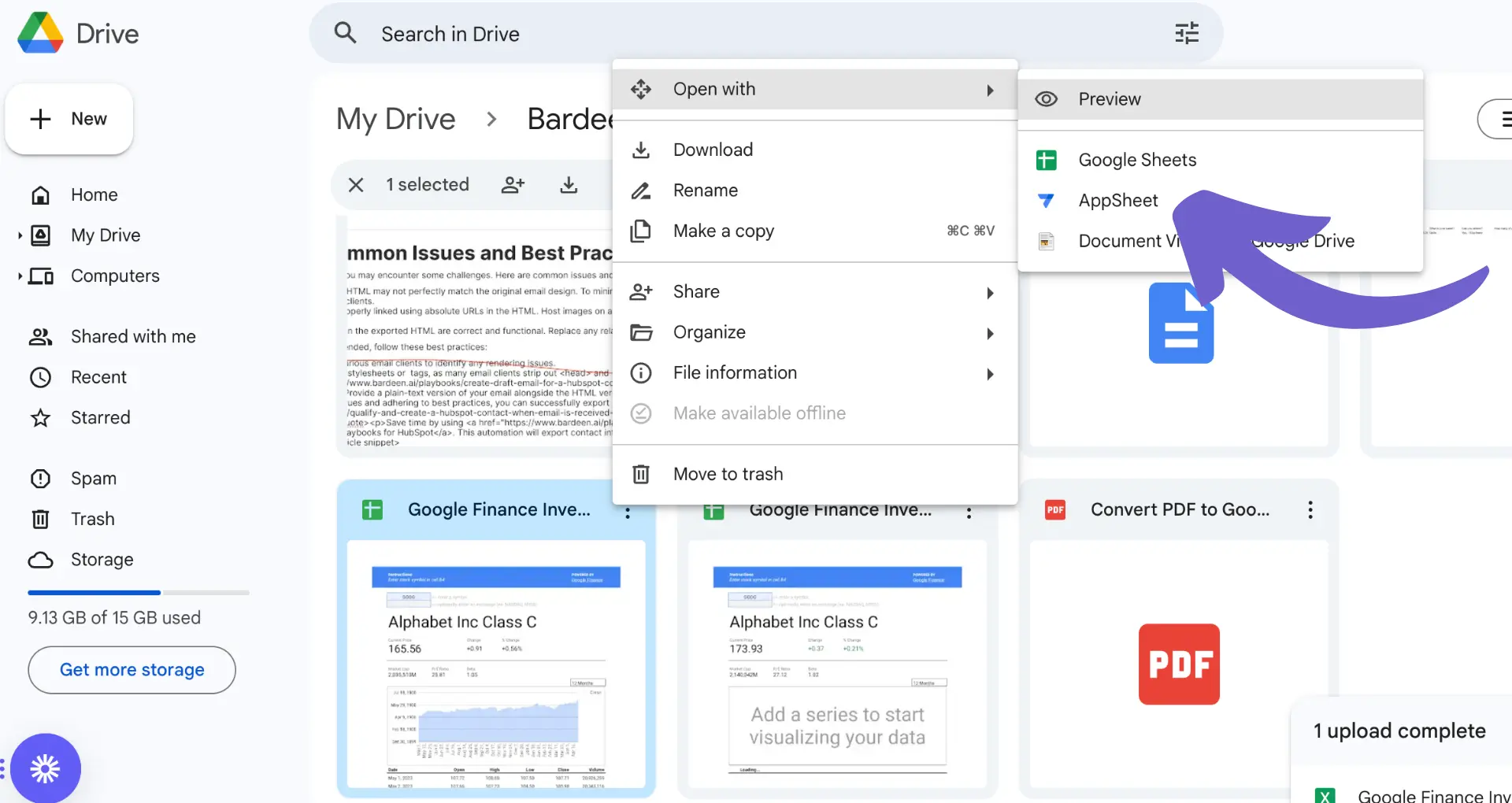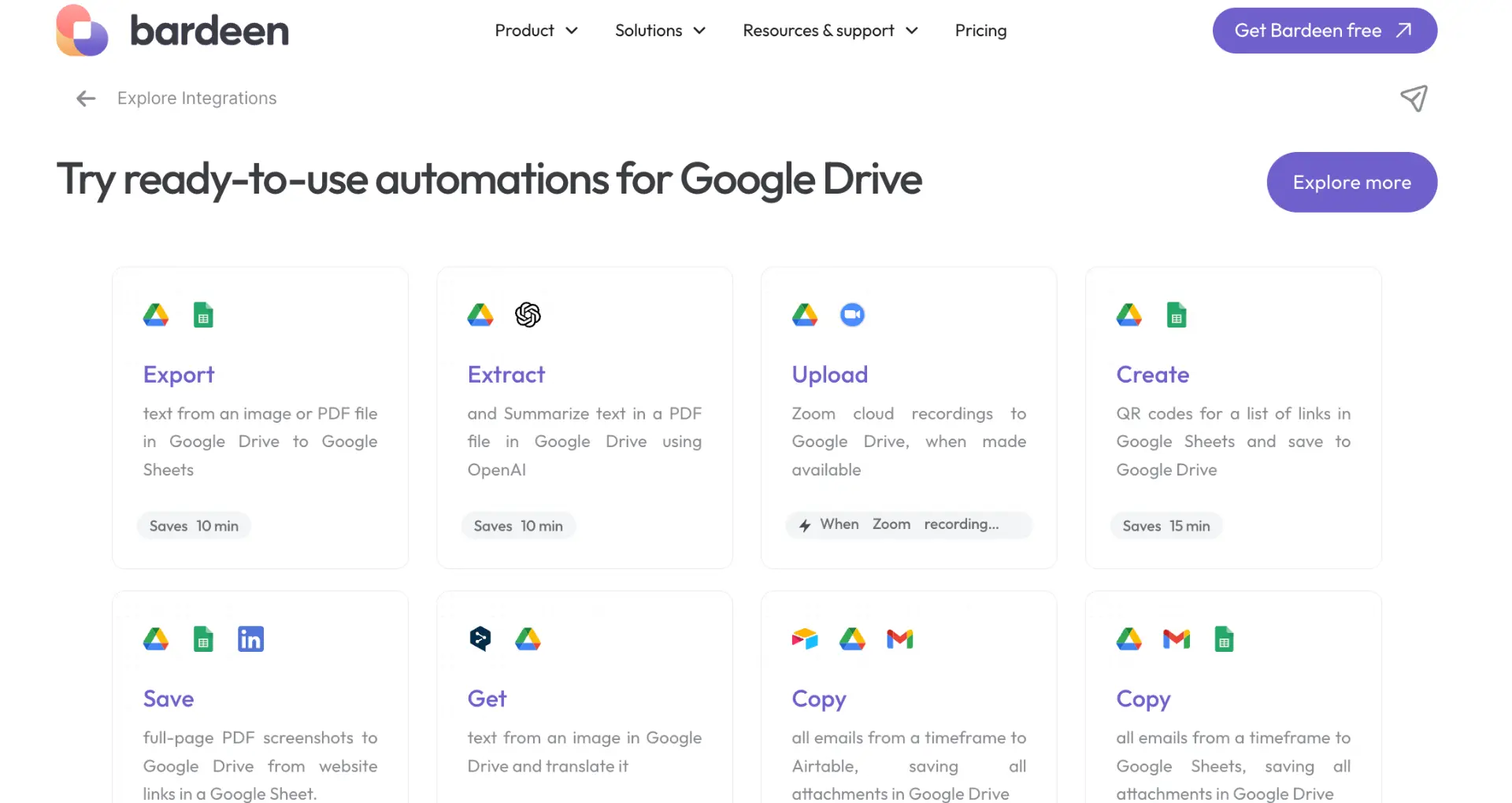Upload the Excel file to Google Drive, then open with Google Sheets.
By the way, we're Bardeen, we build a free AI Agent for doing repetitive tasks.
If you often convert Excel to Google Sheets, check out our GPT in Spreadsheets feature. It automates tasks and can save you time.
Converting Microsoft Excel files to Google Sheets is a common task for many professionals and students. While the process may seem straightforward, there are several factors to consider to ensure a smooth transition between the two platforms. In this step-by-step tutorial, we'll guide you through the process of converting various types of Excel files to Google Sheets, preserving formatting, and troubleshooting common issues.
Understanding File Compatibility and Conversion
When converting Microsoft Excel files to Google Sheets, it's essential to understand the different file types and their compatibility. Excel supports various file formats, including:
- .xls (Excel 97-2003 Workbook)
- .xlsx (Excel Workbook)
- .xlsm (Excel Macro-Enabled Workbook)
- .xltx (Excel Template)
- .xltm (Excel Macro-Enabled Template)
Google Sheets can open and convert most of these Excel file types, but there are some technical differences to keep in mind. Excel files (.xls and .xlsx) use a binary format, while the newer .xlsx format is based on XML (eXtensible Markup Language). Google Sheets, on the other hand, uses its own web-based format that is optimized for online collaboration and real-time editing.
When converting an Excel file to Google Sheets, the content and most of the formatting will be preserved. However, some advanced features, such as complex macros, pivot tables, and certain chart types, may not be fully supported or may require additional adjustments after the conversion process.
If you need to work with both Excel and Google Sheets, consider using Microsoft Excel integration to automate tasks and improve workflow efficiency.

Step-by-Step Conversion Using Google Drive
Converting an Excel file to Google Sheets using Google Drive is a simple process. Here's how to do it:
- Upload the Excel file to your Google Drive. You can do this by clicking the "New" button, then selecting "File upload" and choosing the Excel file from your computer.
- Once the file is uploaded, double-click on it to open a preview.
- In the preview window, click on the "Open with" dropdown menu located at the top of the screen.
- Select "Google Sheets" from the list of available applications. This will convert the Excel file to a Google Sheets format and open it in a new tab.

After following these steps, your Excel file will be converted to a Google Sheets file, and you can start editing and collaborating on it with others. It's important to note that some advanced Excel features, such as complex macros or certain formatting options, may not be fully supported in Google Sheets. However, for most basic to intermediate spreadsheets, the conversion process should preserve the majority of the data and formatting. For more advanced tasks, consider using GPT in Spreadsheets to streamline your workflow.
Bardeen can help you integrate Google Drive with other apps, automate file management, and keep everything organized effortlessly.

Advanced Techniques for Preserving Excel Formatting
When converting an Excel file to Google Sheets, you may encounter issues with complex formatting not being preserved. Here are some methods to retain that formatting:
- Use Google Sheets' built-in formatting tools: After converting your Excel file, you can manually reapply some of the formatting using Google Sheets' formatting options, such as conditional formatting, custom number formats, and cell merging.
- Copy and paste formatting: If you have a particularly complex sheet, you can copy the entire sheet in Excel and paste it into a new sheet in Google Sheets using the Paste special option and selecting "Paste format only." This will preserve most of the formatting, but you'll need to copy and paste the values separately.
- Use add-ons: There are several Google Sheets add-ons, such as "Excel to Sheets" or "Format Converter," that can help preserve formatting during the conversion process. These add-ons may not be perfect, but they can save time and effort.
Common issues with formatting loss include:
- Conditional formatting rules not being carried over
- Custom cell styles being lost
- Merged cells becoming unmerged
- Data validation rules disappearing
To address these issues, you may need to recreate the formatting rules in Google Sheets manually. It's also a good idea to double-check your sheet after conversion to ensure that all data and formatting is correct. For more advanced solutions, try using tools that automate data enrichment in Google Sheets.
Converting Excel Macros to Google Apps Script
When you convert an Excel file containing VBA macros to Google Sheets, the macros won't automatically work because Google Sheets uses a different scripting language called Google Apps Script. Here's what you need to know about converting Excel macros to Google Apps Script:
- VBA (Visual Basic for Applications) is the programming language used for macros in Excel, while Google Apps Script is based on JavaScript and is used for automating tasks and extending functionality in Google Sheets and other Google apps.
- While both VBA and Apps Script can be used to automate tasks and create custom functions, they have different syntax and capabilities.
- To convert your Excel macros to Google Sheets, you'll need to manually rewrite the code in Apps Script. This process can be time-consuming, especially if you have complex macros.
Some key differences between VBA and Apps Script include:
- Language: VBA is based on Visual Basic, while Apps Script is based on JavaScript.
- Integrated Development Environment (IDE): Excel has a built-in VBA editor, while Google Sheets uses a separate online Apps Script editor.
- API and services: Apps Script can integrate with various Google services and APIs, while VBA is limited to the functionality available within Excel and other Microsoft Office applications.
When converting your macros, keep in mind that some VBA functions and features may not have direct equivalents in Apps Script. You may need to find alternative methods or workarounds to achieve similar results. For more advanced automation, consider using AI web scraping tools.
Take advantage of Bardeen's automation features to save time and focus on important tasks. Let Bardeen handle repetitive work with a single click.
Troubleshooting Common Issues in Conversion
When converting Excel files to Google Sheets, you may encounter various issues that can cause errors or unexpected results. Here are some common problems and their solutions:
- Broken links: If your Excel file contains external links to other files or web pages, these links may break when converted to Google Sheets. To fix this, you'll need to manually update the links in your Google Sheets file.
- Unsupported formulas: Some Excel formulas may not work in Google Sheets, particularly those that use Excel-specific functions or structured references. To resolve this, you'll need to rewrite the formulas using Google Sheets-compatible functions and cell references.
- Formatting issues: Complex formatting in Excel, such as conditional formatting or custom cell styles, may not transfer correctly to Google Sheets. You may need to manually reapply the formatting in Google Sheets or find alternative ways to achieve the desired visual appearance.
- Data validation: Excel's data validation settings may not carry over to Google Sheets. You'll need to recreate the data validation rules in Google Sheets to ensure data integrity.
- Macro compatibility: As mentioned earlier, Excel macros written in VBA will not work in Google Sheets. You'll need to rewrite the macros using Google Apps Script.
If you encounter an error or unexpected behavior during the conversion process, first check if the issue is related to unsupported features or compatibility differences between Excel and Google Sheets. Consult the Google Sheets documentation or explore how to scrape data from websites for more advanced solutions and workarounds for your specific problem.
Boost Your Google Sheets with Bardeen Automations
Converting Excel files to Google Sheets not only allows users to take advantage of Google Sheets' collaboration features but also opens up a world of possibilities with automation. Instead of manually transferring data and running repetitive tasks, users can automate their workflows using Bardeen, significantly enhancing productivity and data management efficiency.
Here are several examples of automations that can be built with Bardeen:
- Copy all Asana tasks to Google Sheets: This playbook automates the transfer of tasks from Asana into Google Sheets, streamlining project management and reporting.
- Save a Google Translate translation to Google Sheets: Seamlessly integrate Google Translate with Google Sheets to save translations, perfect for managing multilingual data or learning a new language.
- Save reviews from Google Maps to Google Sheets: Automate the collection of Google Maps reviews into Google Sheets for analysis, improving insights into customer feedback or competitor research.
These playbooks demonstrate just a fraction of what's possible when you combine the power of Google Sheets with Bardeen's automation capabilities. Explore more and streamline your workflow today.







.svg)
.svg)
.svg)
